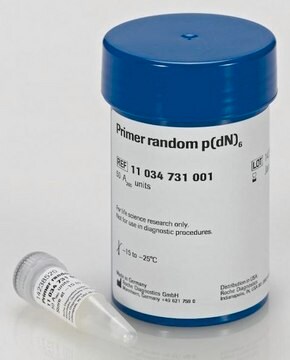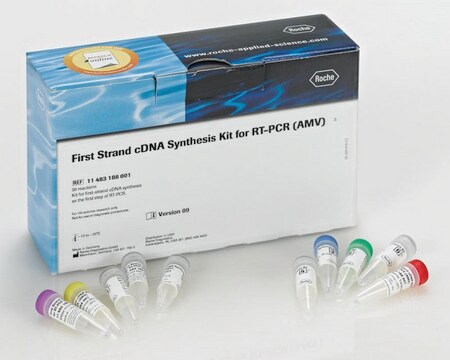Wszystkie zdjęcia(1)
Kluczowe dokumenty
R7647
Random Nonamers
for use as primers in cDNA synthesis, 50 μM in H2O
Synonim(y):
Oligodeoksynukleotydy
Zaloguj sięWyświetlanie cen organizacyjnych i kontraktowych
About This Item
Kod UNSPSC:
41105500
NACRES:
NA.31
Polecane produkty
klasa czystości
Molecular Biology
for molecular biology
Formularz
liquid
zastosowanie
0.1 mL sufficient for 100 RT-PCR reactions
stężenie
50 μM in H2O
Warunki transportu
wet ice
temp. przechowywania
−20°C
Opis ogólny
Random Nonamers are random sequences of nine deoxyribonucleotides (9-mers) used to prime mRNA, with or without a poly(A) tail. Random nonamers may be used as universal, non-specific primers.
Zastosowanie
Random Nonamers are suitable for:
- First-strand cDNA synthesis
- Preparing cDNA libraries (with oligo (dT) primers
- Prepare labeled DNA probes for hybridizations
Cechy i korzyści
- When preparing cDNA libraries or dealing with situations where specific primers are not suitable, the random nonamers can be combined with anchored oligo (dT)23 primers (Product No. O4387).
- In cases of incomplete or missing sequence information, or when specific primers are not effective, the random nonamers offer a solution for cDNA library preparation.
- The random nonamers′ priming capability at higher temperatures (up to 65°C) is reduced, ensuring that they do not interfere with polymerase chain reaction(PCR) following transcription.
- Randomnonamers can also be used to prepare labeled DNA probes for hybridizationstudiesRandom nonamers serve as alternatives to specific reverse transcription (RT) primers for first-strand synthesis, cDNA library construction, and other applications.
Komponenty
Random Nonamers are provided as a 50 uM solution in water.
Inne uwagi
For laboratory use only. Not for drug, household, or other uses.
Ta strona może zawierać tekst przetłumaczony maszynowo.
produkt powiązany
Numer produktu
Opis
Cennik
Kod klasy składowania
12 - Non Combustible Liquids
Klasa zagrożenia wodnego (WGK)
WGK 1
Temperatura zapłonu (°F)
Not applicable
Temperatura zapłonu (°C)
Not applicable
Środki ochrony indywidualnej
Eyeshields, Gloves, type N95 (US)
Wybierz jedną z najnowszych wersji:
Masz już ten produkt?
Dokumenty związane z niedawno zakupionymi produktami zostały zamieszczone w Bibliotece dokumentów.
Klienci oglądali również te produkty
Sambrook, J., et al.
Molecular Cloning: A Laboratory Manual, 10-10 (1989)
P Goelet et al.
Proceedings of the National Academy of Sciences of the United States of America, 79(19), 5818-5822 (1982-10-01)
Oligonucleotide primers have been used to generate a cDNA library covering the entire tobacco mosaic virus (TMV) RNA sequence. Analysis of these clones has enabled us to complete the viral RNA sequence and to study its variability within a viral
Hsiao-Wen Lin et al.
Journal of neurochemistry, 111(3), 808-818 (2009-08-29)
Interleukin-6 (IL-6) is produced by neurons, astrocytes, and microglia, and elevated levels of IL-6 within the CNS have been documented in multiple neurological disorders including Alzheimer's disease, stroke, epilepsy, attention deficit disorder, cerebral palsy, and multiple sclerosis. Here, we sought
E M Brooks et al.
BioTechniques, 19(5), 806-812 (1995-11-01)
The secondary structure in mRNA is essential for many processes, but it can present a technical problem in making full-length cDNA with reverse transcriptases. Furthermore, different reverse transcriptases have differing abilities to transcribe through regions with secondary structure, which can
Ondrej Hajdusek et al.
Proceedings of the National Academy of Sciences of the United States of America, 106(4), 1033-1038 (2009-01-28)
Ticks are among the most important vectors of a wide range of human and animal diseases. During blood feeding, ticks are exposed to an enormous amount of free iron that must be appropriately used and detoxified. However, the mechanism of
Nasz zespół naukowców ma doświadczenie we wszystkich obszarach badań, w tym w naukach przyrodniczych, materiałoznawstwie, syntezie chemicznej, chromatografii, analityce i wielu innych dziedzinach.
Skontaktuj się z zespołem ds. pomocy technicznej












![Enhanced Avian Reverse Transcriptase [eAMV™ RT] For reverse transcription at higher temperatures & rare mRNAs](/deepweb/assets/sigmaaldrich/product/images/496/245/af9bcef6-1474-494b-8fba-32ca0fd56c42/640/af9bcef6-1474-494b-8fba-32ca0fd56c42.jpg)

